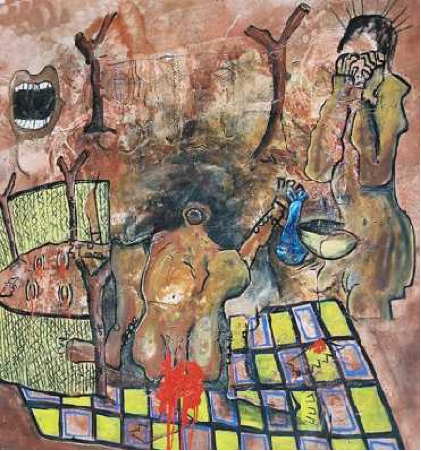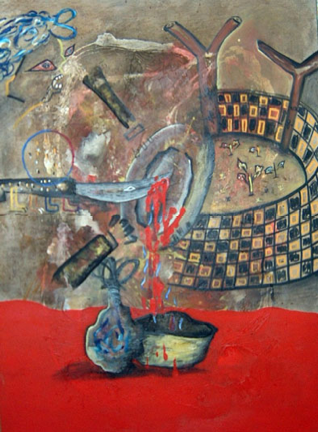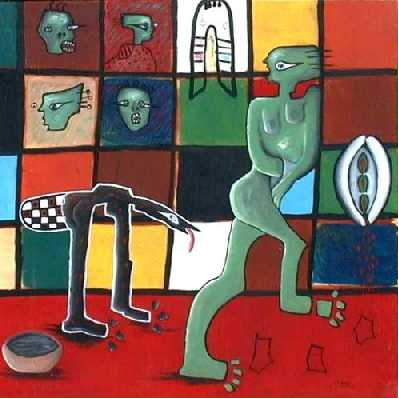Suzanne Ouedraogo – An artist speaks out against FGM
Oct 12th, 2009 by Sarah Dear

Excision I, 2003 150 x 150 cm Acrylic on canvas: Ronald Jung in Dusseldorf, Germany

Excision II, 2003 150 x 180 cm Acrylic on canvas: Ronald Jung in Dusseldorf, Germany

Excision III, 2003 150 x 150 cm Acrylic on canvas: Ronald Jung in Dusseldorf, Germany
Sometimes the subaltern doesn’t speak. Sometimes, people paint. Suzanne Ouedraogo’s (pronounced “Wa-dra-o-go”) lives in Burkina Faso, where female genital mutilation (FGM) or “female circumcision” is the norm. The excision includes either the partial or entire removal of the clitoris and/or the inner labia. The age at which a woman undergoes this practice depends on her region and ethnic group. Members of the Mossi (the largest ethnic group in Burkina Faso) excise their daughters at around age seven, while other groups’ traditions range from birth to just before the women’s marriage or first child. Typically older women perform the procedure for about US$2-3 per patient, and without anesthesia. Complications are practically expected and include, infection, hemorrhaging, anemia, damage to surrounding tissue, incontinence and even death. This practice is based the misogynist belief that women would only remain faithful to their husbands if sex were made terribly painful. Traditional thought says that an infant will die if it touches the clitoris of its unexcised mother during childbirth, or that excision enhances a woman’s childbearing capacity. It has always been a rite of passage to womanhood. The rationales beyond tradition for the practice today include “aesthetic and sanitary factors”. Though made illegal in 1997, a 1999 Demographic and Health Survey of 6,445 women nationally showed that 71.6% of the women of Burkina Faso, regardless of class, religion, region or ethnic group, have undergone this procedure.
What is not normal in Burkina Faso is a woman speaking out, especially on issues of gender and sexuality. This makes it all the more important to listen to her when she does. In urban Burkina Faso, in cities such as Ouagadougou where Suzanne makes her art, women are more disconnected from the pressures of village womanhood, and often see FGM as way to continue the repression of women. Suzanne has little support from the artist community in West Africa, who considers her work far too risky. Nonetheless, her series posted above, in which all pieces are simply titled “Excision”, undauntedly opens up the dialogue on women’s (and all humanity’s) rights and oppression.
In the first piece posted, there are horrendously graphic images of a young woman screaming in agony after or during the procedure. She has deliberately deformed the figures, making them seem broken and nightmarish. The woman’s left leg is left as a mere outline, as if she is disappearing. Also interesting in the subject matter is the woman, naked and vulnerable, choosing not to see, not to act. Opposite to her, the mouth screams yet has no body, no means of empowerment. In the next two paintings, images of the bleeding female genitals are easily understood, and the surrounding phallic trees serve as a reminder of why FGM continues. According to Ouedraogo, it is because of the continued suppression of women by males. Women are not yet granted full power over their own bodies. Though not present for the event, as the shapes are bodiless, their presence is overwhelming and dominant. In the second piece, as in all the paintings, the pervasive red obviously symbolizing blood, pain and anger. The woman is portrayed as green, representing life, youth, and newness. This is echoed in the third painting in the series. The garden of the woman’s body contains precious few flowers, but is a place of new life, and hope. But the garden is walled, and the world suffers its loss. Another interesting piece of imagery to note in this painting is that the knife has been given many feet, a body and a face. It makes us question who the different players in this issue are, from the woman “just doing her job”, to the bystanders, the family, the collective “society” of which we are all a part of…
Purposely ugly, these paintings are effective at achieving the repulsion many people feel FGM needs and deserves. They are an amazing example of “subaltern” women speaking for themselves. Often people defend FGM by accusing Western thought or Christian missionaries of trying to erase African traditions. Young Mossi girls are traditionally secluded during the cutting and taught about their future duties as young women and mothers. The end of the seclusion is a time of “great honor and joy” for young women, marked by a village-wide celebration with drinking and dancing. (It is important to note occasions such as those when women have “unconverted” from the Christian church when told not to undergo the prodedure.) The legacy of colonialism is awkwardly working against its own ideals. Because of the historical colonial disrespect for non-western customs, it seems that anything of foreign influence, for better or for worse, can be disregarded as detrimental to African identity. And understandably so, but here is a Burkinabé woman, not the proverbial white guy, stating the ugliness of tradition that hurts its people and demanding progress.
Suzanne Ouedraogo’s work is gaining popularity across Europe. The world has been given a great opportunity to “magnify the voice” of Suzanne and women like her. This is an painter who uses her art to capture the rallying cry of Africa’s women, refusing to just sell tourists pretty paintings Africa’s happy wildlife they can mount on their walls back home. Her art is challenging and provoking, and the more people who are exposed to it, the more walk away wonderfully disturbed.
4 Responses to “Suzanne Ouedraogo – An artist speaks out against FGM”
I think these pictures are very graphic and express to us very strongly about the feelings of the artist. The use of red in these three pieces are very distinct and I can understand the meaning of each pieces very easily. I am particularly interested in the second piece. I like how there is a knife in the plate trying to symbolize how their livelihood and food is taken away from them. Also, the farm in the background is like how they lived and there are only sprouts growing. The other two pieces expresses the unfairness women endure. In the first piece, there is a person hiding their face because of the violence done to the forefigure. Also, there is a mouth on the left corner which symbolizes how they want to be heard because it is an open mouth. I agree with the idea that subaltern can speak through paintings. It is another medium that allows the dispossessed to voice their opinions and experiences. I think these paintings are great ways to do that
Although the entire FGM practice is a horrendous violation on a female body, it is still very difficult to fight it in many societies. Yes we know that the woman here is presented as the subaltern and the oppressed. But in many societies which practice FGM, the women (the subaltern) are often not willing to speak against it. Mostly because it is culturally regarded as an important symbol of respect and identity. In fact if you speak to many women in the villages who have been through it, they are proud of it (similar case with the veil in some muslim societies).
The “brainwashing” is not only to women, but even men in these communities are made to believe that, the best woman is a circumcised one and it is a dishonour if a man gets married to a non-circumcised girl (and marriage is the path that most people especially in these “confined” communities want to take).
My point here is that, what is the solution when the subaltern (at least in our sense) embraces his/her position? When this act seems to us as terrible and inhumane but to them as a necessary act to be accepted in the society?
I am aware of some good effort going on and most communities are being reached and changes are happening. The best way proven to go about bringing this change is “the change from within the communities.” This is an ongoing transformation. It does not happen overnight and is highly unsuccessful if attempted through outsiders’ condemnations. It works best when the elderly women (known as “ngariba” in some society) who perfom the act are convinced of the dangers of the act.
I’m ready to get lambasted: this is one case in which I think cultural relativism goes out the window. Tradition, religion, and history are a weak excuse for mutilation, humiliation, and torture. Throughout most of recorded history, women were thought of as the property of men and until very recently, it was considered traditional for women to stay barefoot, pregnant, and in the kitchen. Both of those ideas seem absolutely absurd now, and I refuse to believe it’s because gender equality is merely a product of western thought. The west doesn’t “own” feminism.
I would argue that cultural hegemony is behind women who practice and support FGM. Even if there is a small minority of women who truly do believe that FGM is a positive practice, it should never be forcibly inflicted on those who don’t.
My thoughts after reading this reminded me of the very extreme statements made by some of the men in the Grameen Bank video regarding the women who received microloans being traitors to Islam. The choice of survival is not a betrayal of faith. A number of us in the class laughed at the sheer ridiculousness of claims that women should stay passive in their homes rather than seek out a way to live and support their children. Not only is that kind of thinking extremely misogynistic, it’s totally impractical. The women in the film were left with few other options.
I feel like the rejection of cultural relativism gets a bad rap these days largely because it was co-opted by proponents of western military intervention in Afghanistan, with the (still problematic) objective of “saving women” (from none other than the Orientalist construction of backwards, oppressive, fanatically religious middle-Eastern men).
But anyway, I agree with Daniel, the best way for change to occur is from within the communities. Suzanne Ouedraogo’s artwork is a jarring yet hopeful step towards that.
a piano…
Hello 🙂 I bookmarked this site. Thanks heaps for this!… if anyone else has anything, it would be much appreciated. Great website Super Pianoforte Links http://www.en.Grand-Pianos.org Enjoy!…